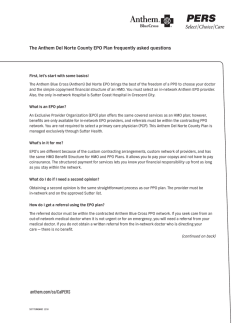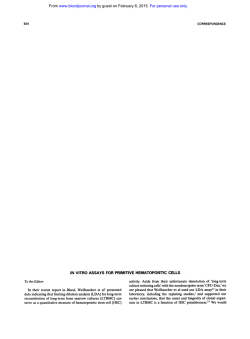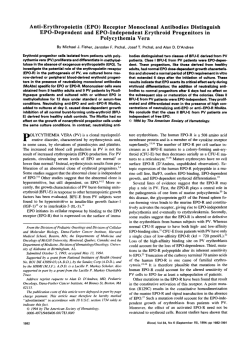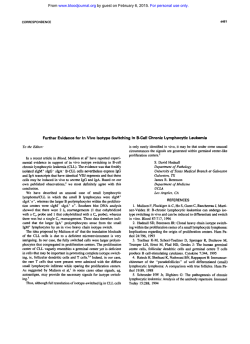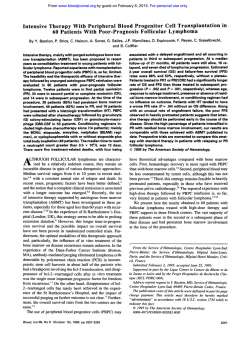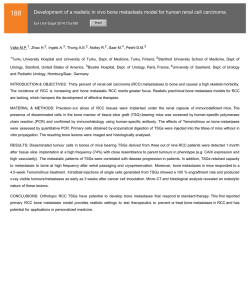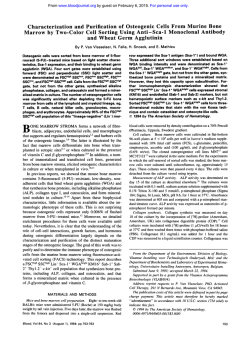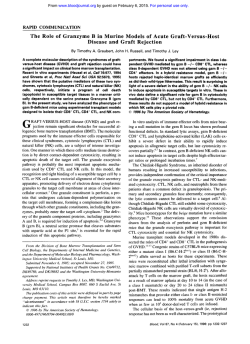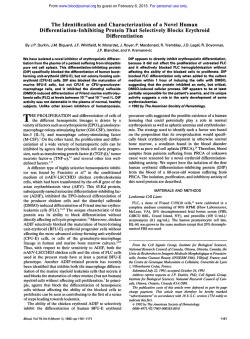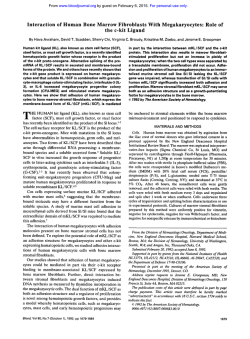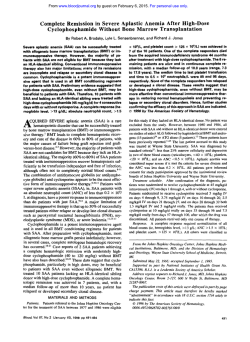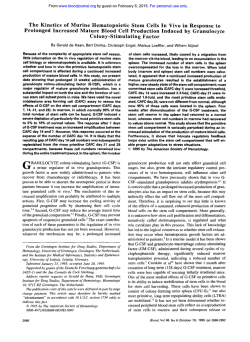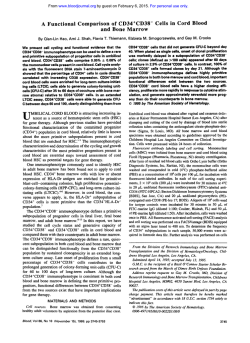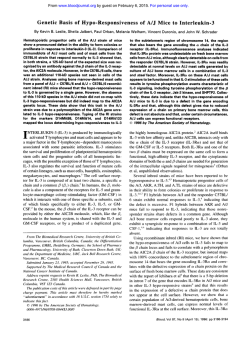
remission after erythropoietin administration for
From www.bloodjournal.org by guest on February 6, 2015. For personal use only. 1378 CORRESPONDENCE REMISSION AFTER ERYTHROPOIETIN ADMINISTRATION FOR ERYTHROLEUKEMIA-A To the Editor: Erythropoietin (EPO) has proved useful for the recovery of anemia under the condition of renal insufficiency or myeloma. In vitro colony assay has shown that EPO stimulates the growth and differentiation of burst-forming unit-erythroid and colony-forming uniterythroid colonies of bone marrow progenitor cells.' It has been noted that marrow erythroblasts in erythroleukemia were decreased CASE STUDY after transfusion, suggesting that a humoral factor such as EPO in serum may contribute to the regulation of erythroleukemia cells.' However, clinicians have withheld application of EPO in erythroleukemia because this agent may stimulate the proliferation of leukemia cells; on the other hand, it has not yet been shown that EPO is capable in vitro to force differentiation of erythroleukemia cells, as all-trans retinoic acid has been observed to do for promyelocytic leukemia cells.' We present here a case of erythroleukemia who From www.bloodjournal.org by guest on February 6, 2015. For personal use only. 1379 CORRESPONDENCE Fig 1. May-Giemsa stain of erythroleukemia bone marrow cells before (A) and after (B) in vitro culture with EPO. achieved complete remission after it was confirmed in vitro that EPO had brought about differentiation of leukemia cells. A 17-year-old male was admitted to our hospital for anemia. His red blood cell (RBC) count was 266 X IO"/pL hemoglobin (Hb) 9.5 g/dL: reticulocyte count 2.7%: white blood cell (WBC) count 1.700/ pL with 42% neutrophils. 54% lymphocytes, and 4%. monocytes: and platelet count 7.5 x IOJ/pL. Nuclear RBCs were found in 36 of I00 RBCs. The bone marrow aspirate disclosed an erythroid dominant marrow with a nuclear cell count of 206.0OO/pL. with 68% erythroid cells. The percentage ofblastsamongnonerythroid mononuclear cells was 37.8%. The erythroid cells showed a high nuclear/ cytoplasmic ratio and were positive for Periodic acid Schiff stain. A diagnosis of erythroleukemia (M6 in the French-American-British classification) was made and he was subsequently treated with. several chemotherapies. including daunomycin. 6-mercaptopurine. €PO 12,000 unltslday 1 7 8 9 10 11 Months after Admission 12 Fig 2. The clinical course after EPO administration. (0)Hb concentration; (0)erythroleukemic cells in the bone marrow; ( 0 )nonerythroid blast cells in the bone marrow. prednisolone. and behenoyl cytosine arabinoside. etc: however, these were not effective. We then investigated the potential ofdifferentiation therapy. The patient's bone marrow aspirates were subjected to Ficoll-Hypaque discontinuous centrifugation and mononuclear cells were obtained. The cells were incubated in 10%fetal calfserum supplemented with Iscove's modified Dulbecco's Medium for 7 days and cultured for another 7 days in the presence of EPO." After EPO addition. the total cell number (0.5 X IO"/mL) started to increase. reached a plateau (3.5 X I Oh/mL)at day 5. and thereafter rapidly decreased. It was noteworthy that the leukemic blasts in culture had almost disappeared and that the erythroblasts and mature RBCs increased by day 7. as shown in the photomicrograph (Fig I ) . These in vitro studies showed that differentiation can he stimulated in erythroleukemia cells by EPO. As the patient was refractory to conventional chemotherapies. we explained his situation and the results of the in vitro study to his family and obtained informed consent to use EPO. EPO was administered subcutaneously at a dose of 12.000 U/d. The patient's clinical course is shown in Fig 2. After 6 days of EPO administration, the Hb value started to increase and the nuclear RBCs had disappeared in the peripheral blood at day 14. Bone marrow aspirate showed a remarkable decrease in megaloblasts and an increase in polychromatic and orthochromatic erythroblasts. By 2 weeks of administration of EPO, the leukemia had gone into remission without any other cytocydal drugs. We decided to continue daily administration of EPO hecause it appeared to be the decisive factor in the patient's general improvement as well as his increase in the Hb. WBC. and platelet count. No donor for a bone marrow transplant could be found with matching HLA. However, 3 months after his first treatment with EPO. the patient developed pancytopenia and showed an increase of unclassified blasts both in peripheral blood and bone marrow. Conventional chemotherapies including cytosine arabinoside and other drugs were ineffective. These blasts were also refractory to EPO addition in vitro. The patient died from cerebral hemorrhage. Erythroleukemia is still one ofthe leukemias with a poor prognosis, because it has a high tendency to deteriorate into acute nonlymphocytic leukemia. Our patient's clinical course strongly suggests that EPO has potential for differentiation therapy of erythroleukemia. As far as we known. this is the first reported case in which EPO From www.bloodjournal.org by guest on February 6, 2015. For personal use only. 1380 CORRESPONDENCE ETSU MIYAZAKI YUTAKA KOHGO MICHIAKI HIRAYAMA JOHJI KAWANlSHl JUNJI KAT0 SUM10 SAKAMAKI YOSHIRO NIITSU Department of Internal Medicine, Section 4 , Sapporo Medical Universiiy, School of Medicine Sapporo, Japan has stimulated differentiation of erythroleukemia cells in vitro as well as substantively improving a patient’s condition. Further clinical studies of this agent seem to be warranted; however, users must take the potential for tumor growth stimulation into account and interrupt the treatment promptly if rapid progression occurs. ACKNOWLEDGMENT We thank G r i n Brewery Co (Tokyo, Japan) for providing recombinant EPO for the management of this case. REFERENCES 1. Gregory CJ, Eaves A C Three stages oferythropoietic progeni- tor cell differentiation distinguished by a number of physical and biologic properties. Blood 5 1527, 1978 2. Gabuzda TG, Shute HE, Erslev AJ: Regulation oferythropoiesis in erythroleukemia. Arch Intern Med 123:60, 1969 3. Breitman TR, Selonick SE, Colines SJ: Induction of differentiation of the human promyelocytic leukemia cell line (HL-60) by retinoic acid. Proc Natl Acad Sci USA 77:2936, 1980 4. Wada H, Suda T, Miura Y, Kajii E, Ikemoto S, Yawata Y: Expression of major blood group antigens on human erythroid cells in a two phase liquid culture system. Blood 75:505. 1990 From www.bloodjournal.org by guest on February 6, 2015. For personal use only. 1993 82: 1378-1380 Remission after erythropoietin administration for erythroleukemia--a case study [letter] E Miyazaki, Y Kohgo, M Hirayama, J Kawanishi, J Kato, S Sakamaki and Y Niitsu Updated information and services can be found at: http://www.bloodjournal.org/content/82/4/1378.citation.full.html Articles on similar topics can be found in the following Blood collections Information about reproducing this article in parts or in its entirety may be found online at: http://www.bloodjournal.org/site/misc/rights.xhtml#repub_requests Information about ordering reprints may be found online at: http://www.bloodjournal.org/site/misc/rights.xhtml#reprints Information about subscriptions and ASH membership may be found online at: http://www.bloodjournal.org/site/subscriptions/index.xhtml Blood (print ISSN 0006-4971, online ISSN 1528-0020), is published weekly by the American Society of Hematology, 2021 L St, NW, Suite 900, Washington DC 20036. Copyright 2011 by The American Society of Hematology; all rights reserved.
© Copyright 2025



